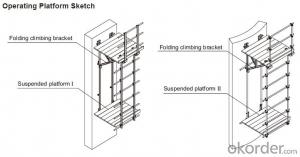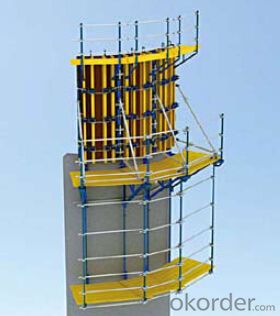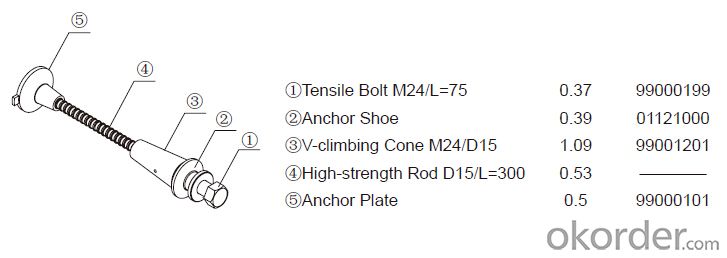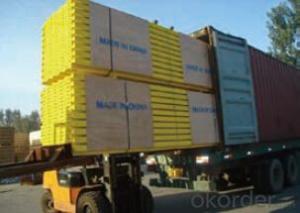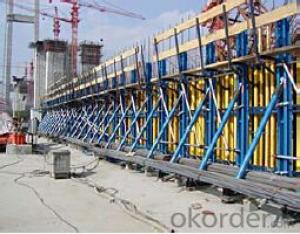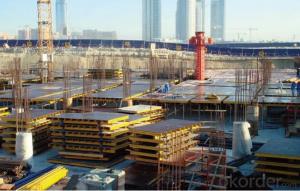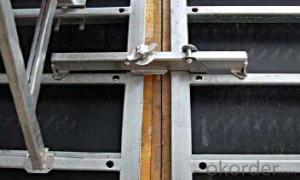Climbing Platform CP-190 for formwork and scaffolding systems
- Loading Port:
- Tianjin
- Payment Terms:
- TT OR LC
- Min Order Qty:
- 50 m²
- Supply Capability:
- 1000 m²/month
OKorder Service Pledge
OKorder Financial Service
You Might Also Like
Climbing Platform CP190
Climbing bracket CP190 is mainly used as operating platform during construction. It can be used
on the vertical wall and arced wall. The bracket hang on the anchor system and all the load are
supported by anchor system. It’s convenient to assemble and dismantle, the construction is easy,
rapid and safe.
Anchor System:
Anchor system is the most important supporting part. The system is made of five parts shown
below. There into, tensile bolt, anchor shoe and V-climbing cone can be taken out for reusing.
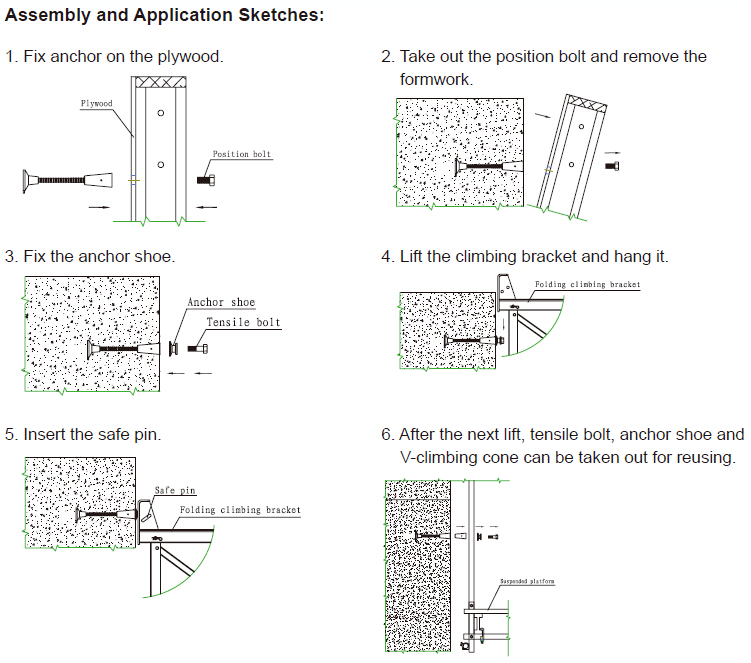
- Q: Can steel formwork be used for both interior and exterior structures?
- Yes, steel formwork can be used for both interior and exterior structures. Steel is a versatile and durable material that can withstand various weather conditions and is suitable for use in both indoor and outdoor environments. It provides excellent strength and stability, making it an ideal choice for constructing structures such as walls, columns, slabs, and beams. Additionally, steel formwork is reusable, which makes it cost-effective and environmentally friendly. Whether it is for interior or exterior construction, steel formwork offers a reliable and efficient solution.
- Q: Can steel formwork be used for railway construction projects?
- Yes, steel formwork can be used for railway construction projects. Steel formwork is a highly durable and versatile material that can withstand the heavy loads and pressures associated with railway construction. It provides a strong and rigid structure for pouring concrete and shaping the desired forms for railway infrastructure, such as tunnels, bridges, platforms, and retaining walls. Steel formwork offers several advantages for railway construction projects. Firstly, it has a high load-bearing capacity, allowing it to support the weight of the concrete and any additional loads. This is particularly important in railway construction, where safety and stability are paramount. Secondly, steel formwork is reusable, making it a cost-effective choice for large-scale projects. It can be easily dismantled, cleaned, and reassembled for future use, reducing the need for additional formwork materials and minimizing waste. Furthermore, steel formwork provides excellent dimensional accuracy and surface finish. It ensures that the concrete structures produced are of high quality and meet the required specifications and standards for railway construction. Additionally, steel formwork is highly resistant to moisture, chemicals, and other environmental factors that can degrade the formwork material. This makes it suitable for both indoor and outdoor railway construction projects, where exposure to harsh weather conditions is common. Overall, steel formwork is a reliable and efficient choice for railway construction projects. Its strength, reusability, dimensional accuracy, and resistance to environmental factors make it an ideal material for shaping and pouring concrete structures in railway infrastructure development.
- Q: What are the typical deflection limits for steel formwork systems?
- The deflection limits of steel formwork systems can vary depending on various factors, such as the project's specific design and application requirements. However, there are commonly followed general guidelines. In most cases, the deflection limits for steel formwork systems are determined based on the span length and the applied load. Typically, deflection limits are restricted to L/360 or L/240, where L represents the span length of the formwork. For instance, if the formwork's span length is 10 feet, the deflection limit would be L/360, which is approximately 0.028 feet or 0.34 inches. This means that the maximum allowable deflection for this formwork system would be 0.34 inches, ensuring stability and minimal deformation under the load. It should be noted that these deflection limits may be adjusted according to project requirements or industry standards. In high-rise construction projects, stricter deflection limits may be enforced to ensure the formwork system's structural integrity and overall safety. Ultimately, careful consideration and evaluation of deflection limits are necessary during the design and construction process of steel formwork systems. Consulting a structural engineer or referring to relevant industry standards can provide more accurate and specific deflection limits for a given system.
- Q: What are the different types of finishes applied to steel formwork surfaces?
- Steel formwork surfaces can be enhanced with various finishes, each serving a specific purpose. These finishes aim to improve the appearance, durability, and performance of the steel formwork. Here are some commonly used finishes: 1. Galvanized Finish: A popular choice for outdoor or high-moisture environments, this finish involves coating the steel with a layer of zinc, offering excellent corrosion resistance. 2. Powder Coating: In this process, a dry powder is electrostatically applied to the steel surface and then cured under heat. The result is a hard, long-lasting finish that resists chipping, scratching, and fading. Powder coatings come in a wide range of colors and textures. 3. Paint Finish: Paint finishes are commonly used to enhance the aesthetics of steel formwork. They provide a smooth, uniform appearance and can be customized to match specific color requirements. Paint finishes also offer some protection against corrosion and weathering. 4. Epoxy Coating: Known for their chemical resistance and durability, epoxy coatings are often used in industrial applications where the steel formwork may be exposed to chemicals, acids, or solvents. These coatings also provide good adhesion and resistance to abrasion. 5. Anodized Finish: The anodizing process forms a layer of aluminum oxide on the steel formwork surface, resulting in enhanced corrosion resistance and a decorative appearance. Anodized finishes are commonly used in architectural applications. 6. Stainless Steel Finish: In certain steel formwork applications, a stainless steel finish may be preferred. Stainless steel is naturally resistant to corrosion and has a sleek, modern appearance. It is often used in environments with high humidity or chemical exposure. These examples highlight the different finishes available for steel formwork surfaces. The choice of finish depends on factors such as the formwork's intended use, desired aesthetics, and environmental conditions it will face.
- Q: Can steel formwork be used for both monolithic and composite construction?
- Yes, steel formwork can be used for both monolithic and composite construction. Monolithic construction refers to the process of pouring concrete in a single continuous operation to form a solid structure. Steel formwork is commonly used in monolithic construction as it provides a strong and durable support system for holding the concrete in place until it sets and hardens. The steel formwork can be easily assembled and disassembled, making it efficient for monolithic construction projects. Composite construction, on the other hand, involves the combination of different materials to create a stronger and more efficient structure. Steel formwork can also be used in composite construction, especially when the concrete is combined with other materials such as steel beams or columns. The steel formwork acts as a mold for the concrete, allowing it to be poured and shaped around the other materials to create the desired structure. Overall, steel formwork is versatile and can be used in various construction methods, including both monolithic and composite construction. Its strength, durability, and ease of use make it a popular choice for contractors and builders in a wide range of construction projects.
- Q: How is steel formwork assembled?
- Steel formwork is assembled by first erecting vertical steel supports which are secured in place. Horizontal steel beams are then connected to the vertical supports to create a sturdy framework. Steel panels are then attached to the framework to form the desired shape of the concrete structure. Finally, the gaps and joints between the steel panels are sealed to ensure proper containment and support during the pouring of concrete.
- Q: Can steel formwork be used for school construction projects?
- Yes, steel formwork can be used for school construction projects. Steel formwork is a durable and versatile construction material that can withstand the heavy loads and pressures encountered in school buildings. It provides a strong and stable framework for concrete pouring, ensuring the structural integrity of the construction. Additionally, steel formwork is reusable, which makes it a cost-effective choice for school construction projects. Its adaptability allows for the creation of various shapes and sizes, catering to the unique architectural designs often seen in school buildings. Furthermore, steel formwork offers faster construction times compared to traditional timber formwork, allowing for quicker completion of school projects. Overall, steel formwork is a suitable and reliable choice for school construction projects.
- Q: What is the lifespan of steel formwork compared to other types of formwork?
- The lifespan of steel formwork is generally longer compared to other types of formwork. Steel is a highly durable material that can withstand frequent use and harsh construction conditions. It has excellent resistance to wear, corrosion, and impact, making it a preferred choice for long-term projects. Additionally, steel formwork can be easily repaired and reused, further extending its lifespan.
- Q: What are the different types of steel used in formwork construction?
- There are several types of steel used in formwork construction, each with their own specific characteristics and applications. 1. Mild Steel: This is the most commonly used type of steel in formwork construction. It is affordable, readily available, and easy to work with. Mild steel is suitable for most formwork applications and offers good strength and durability. 2. High Tensile Steel: This type of steel is stronger than mild steel and has a higher tensile strength, making it ideal for heavy-duty formwork structures. High tensile steel provides enhanced resistance to bending and deformation under heavy loads, making it suitable for large-scale construction projects. 3. Reinforcing Steel: Reinforcing steel, also known as rebar, is used in formwork construction to reinforce concrete structures. It is typically made of carbon steel and is available in various grades and sizes. Reinforcing steel is used to increase the tensile strength of concrete and improve its resistance to cracking and structural failure. 4. Stainless Steel: Stainless steel is used in formwork construction when corrosion resistance is a primary concern. It is particularly suitable for formwork exposed to harsh environmental conditions or in contact with corrosive materials. Stainless steel offers excellent resistance to corrosion, making it a durable and long-lasting option for formwork construction. 5. Alloy Steel: Alloy steel is a type of steel that is mixed with other elements to enhance its properties. It is commonly used in formwork construction for its high strength, toughness, and resistance to wear and tear. Alloy steel can withstand heavy loads and is often used in formwork systems that require superior performance and durability. Overall, the choice of steel used in formwork construction depends on the specific requirements of the project, including load-bearing capacity, durability, and resistance to corrosion. It is important to select the appropriate type of steel to ensure the safety and longevity of the formwork structure.
- Q: How does steel formwork contribute to improved construction quality?
- Steel formwork contributes to improved construction quality in several ways: 1. Durability: Steel formwork is highly durable and can withstand repetitive use, resulting in consistent and accurate construction. It does not deform or warp easily, ensuring a high-quality finish. 2. Stability: Steel formwork provides excellent stability during concrete pouring, preventing any shifting or movement of the formwork. This stability leads to precise and even concrete placement, resulting in a structurally sound and robust construction. 3. Flexibility: Steel formwork can be easily customized and adapted to various shapes and sizes, allowing for the construction of complex structures with intricate details. This flexibility ensures that the final product meets the desired specifications and design requirements. 4. Reusability: Steel formwork is reusable, making it a cost-effective option for construction projects. By eliminating the need for constant replacement, it reduces waste and contributes to sustainable construction practices. 5. Enhanced productivity: Steel formwork enables faster construction compared to traditional formwork methods. Its ease of assembly and disassembly, along with its ability to support multiple pours, allows for increased workflow and efficiency on the construction site. Overall, steel formwork offers superior strength, stability, and versatility, resulting in improved construction quality by facilitating precise concrete placement, durability, and cost-effectiveness.
Send your message to us
Climbing Platform CP-190 for formwork and scaffolding systems
- Loading Port:
- Tianjin
- Payment Terms:
- TT OR LC
- Min Order Qty:
- 50 m²
- Supply Capability:
- 1000 m²/month
OKorder Service Pledge
OKorder Financial Service
Similar products
Hot products
Hot Searches
Related keywords


